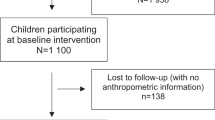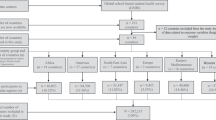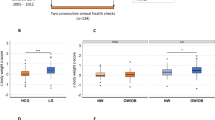Abstract
Background/Objectives
To prospectively investigate the predictors of overweight/obesity and of body mass index (BMI) change in schoolchildren.
Subjects/Methods
A cohort of 2755 Irish children (53.7% girls), aged 6−10 years at baseline, participating in the Childhood Obesity Surveillance Initiative were included. Height and weight were objectively measured and BMI was calculated. Overweight/obesity were defined according to the International Obesity Task Force cut-offs. Prevalence of overweight/obesity at baseline and follow-up, incidence of overweight/obesity and changes in BMI over time were computed. Lifestyle indicators were parentally reported with a questionnaire. Predictors of overweight/obesity were investigated by multivariate mixed logistic regression models.
Results
Baseline BMI (OR = 6.46, 95% CI = 4.56−9.17) and school socioeconomic level (OR = 2.12, 95% CI = 1.16−3.86) were associated with higher risk of becoming overweight/obese. Children with no savoury snacks consumption (OR = 0.22, 95% CI = 0.07−0.69), or with frequent sports/dancing clubs attendance (OR = 0.41, 95% CI = 0.19−0.88) had lower odds of overweight/obesity at follow-up. Poor fruit intake was associated with higher risk of overweight/obesity (OR = 2.16, 95% CI = 1.23−3.78).
Conclusions
Initial BMI was the main predictor of subsequent overweight/obesity in schoolchildren, followed, to a lesser extent, by school socioeconomic status. Although lifestyle behaviours appeared to have lower effect as compared with prior BMI, children with healthier lifestyle behaviours were at reduced risk of overweight/obesity at follow-up. Programmes that aim at preventing the onset of overweight and obesity need to be a priority given the existing difficulties to reverse this condition later in life.
This is a preview of subscription content, access via your institution
Access options
Subscribe to this journal
Receive 12 print issues and online access
$259.00 per year
only $21.58 per issue
Buy this article
- Purchase on Springer Link
- Instant access to full article PDF
Prices may be subject to local taxes which are calculated during checkout
Similar content being viewed by others
References
Ng M, Fleming T, Robinson M, Thomson B, Graetz N, Margono C, et al. Global, regional, and national prevalence of overweight and obesity in children and adults during 1980-2013: a systematic analysis for the Global Burden of Disease Study 2013. Lancet. 2014;384:766–81.
Lobstein T, Jackson-Leach R. Planning for the worst: estimates of obesity and comorbidities in school-age children in 2025. Pediatr Obes. 2016;11:321–5.
Ahrens W, Pigeot I, Pohlabeln H, De Henauw S, Lissner L, Molnar D, et al. Prevalence of overweight and obesity in European children below the age of 10. Int J Obes. 2014;38(Suppl 2):S99–107.
Llewellyn A, Simmonds M, Owen CG, Woolacott N. Childhood obesity as a predictor of morbidity in adulthood: a systematic review and meta-analysis. Obes Rev. 2016;17:56–67.
Comission on Ending Childhood Obesity. Facts and figures on childhood obesity. World Health Organisation. 2018. http://www.who.int/end-childhood-obesity/facts/en/. Accessed 24 Mar 2018.
Olafsdottir S, Berg C, Eiben G, Lanfer A, Reisch L, Ahrens W, et al. Young children’s screen activities, sweet drink consumption and anthropometry: results from a prospective European study. Eur J Clin Nutr. 2014;68:223–8.
Pala V, Lissner L, Hebestreit A, Lanfer A, Sieri S, Siani A, et al. Dietary patterns and longitudinal change in body mass in European children: a follow-up study on the IDEFICS multicenter cohort. Eur J Clin Nutr. 2013;67:1042–9.
te Velde SJ, van Nassau F, Uijtdewilligen L, van Stralen MM, Cardon G, De Craemer M, et al. Energy balance-related behaviours associated with overweight and obesity in preschool children: a systematic review of prospective studies. Obes Rev. 2012;13(Suppl 1):56–74.
Jackson SL, Cunningham SA. The stability of children’s weight status over time, and the role of television, physical activity, and diet. Prev Med. 2017;100:229–34.
Kerr JA, Long C, Clifford SA, Muller J, Gillespie AN, Donath S, et al. Early-life exposures predicting onset and resolution of childhood overweight or obesity. Arch Dis Child. 2017;102:915–22.
Dietz WH. Critical periods in childhood for the development of obesity. Am J Clin Nutr. 1994;59:955–9.
Wijnhoven TM, van Raaij JM, Spinelli A, Rito AI, Hovengen R, Kunesova M, et al. WHO European Childhood Obesity Surveillance Initiative 2008: weight, height and body mass index in 6−9-year-old children. Pediatr Obes. 2013;8:79–97.
Wijnhoven T, Branca F. WHO European Childhood Obesity Surveillance Initiative. Protocol, Version January 2008.. Copenhagen: WHO Regional Office for Europe; 2008.
Cole TJ, Bellizzi MC, Flegal KM, Dietz WH. Establishing a standard definition for child overweight and obesity worldwide: international survey. BMJ. 2000;320:1240–3.
Cole TJ, Flegal KM, Nicholls D, Jackson AA. Body mass index cut offs to define thinness in children and adolescents: international survey. BMJ. 2007;335:194.
Freeman JV, Cole TJ, Chinn S, Jones PR, White EM, Preece MA. Cross sectional stature and weight reference curves for the UK, 1990. Arch Dis Child. 1995;73:17–24.
Central Statistics Office. Profile 1—Town and Country. Dublin: Central Office Statistics, Dublin; 2012.
Department of Education and Skills. DEIS: delivering equality of opportunity in schools. Dublin: Department of Education and Skills. 2017. http://www.education.ie/en/Schools-Colleges/Services/DEIS-Delivering-Equality-of-Opportunity-in-Schools-/FAQs.html. Accessed 6 Jul 2018.
Archer P, Sofroniou N. The assessment of levels of disadvantage in primary schools for DEIS. Dublin: Educational Research Centre. 2018. http://www.erc.ie/documents/deis_assess_disadv_prim_sch.pdf. Accessed 6 Jul 2018.
Dunkler D, Plischke M, Leffondre K, Heinze G. Augmented backward elimination: a pragmatic and purposeful way to develop statistical models. PLoS ONE. 2014;9:e113677.
Niclasen BV, Petzold MG, Schnohr C. Overweight and obesity at school entry as predictor of overweight in adolescence in an Arctic child population. Eur J Public Health. 2007;17:17–20.
Chen TA, Baranowski T, Moreno JP, O’Connor TM, Hughes SO, Baranowski J, et al. Obesity status transitions across the elementary years: use of Markov chain modelling. Pediatr Obes. 2016;11:88–94.
Kamath CC, Vickers KS, Ehrlich A, McGovern L, Johnson J, Singhal V, et al. Clinical review: behavioral interventions to prevent childhood obesity: a systematic review and metaanalyses of randomized trials. J Clin Endocrinol Metab. 2008;93:4606–15.
Stuart B, Panico L. Early-childhood BMI trajectories: evidence from a prospective, nationally representative British cohort study. Nutr Diabetes. 2016;6:e198.
Ziyab AH, Karmaus W, Kurukulaaratchy RJ, Zhang H, Arshad SH. Developmental trajectories of Body Mass Index from infancy to 18 years of age: prenatal determinants and health consequences. J Epidemiol Community Health. 2014;68:934–41.
Taveras EM, Rifas-Shiman SL, Sherry B, Oken E, Haines J, Kleinman K, et al. Crossing growth percentiles in infancy and risk of obesity in childhood. Arch Pediatr Adolesc Med. 2011;165:993–8.
Wu S, Ding Y, Wu F, Li R, Hu Y, Hou J, et al. Socio-economic position as an intervention against overweight and obesity in children: a systematic review and meta-analysis. Sci Rep. 2015;5:11354.
Ruijsbroek A, Wijga AH, Kerkhof M, Koppelman GH, Smit HA, Droomers M. The development of socio-economic health differences in childhood: results of the Dutch longitudinal PIAMA birth cohort. BMC Public Health. 2011;11:225.
Li X, Memarian E, Sundquist J, Zoller B, Sundquist K. Neighbourhood deprivation, individual-level familial and socio-demographic factors and diagnosed childhood obesity: a nationwide multilevel study from Sweden. Obes Facts. 2014;7:253–63.
Emmett PM, Jones LR. Diet, growth, and obesity development throughout childhood in the Avon Longitudinal Study of Parents and Children. Nutr Rev. 2015;73(Suppl 3):175–206.
Leech RM, McNaughton SA, Timperio A. Clustering of diet, physical activity and sedentary behaviour among Australian children: cross-sectional and longitudinal associations with overweight and obesity. Int J Obes. 2015;39:1079–85.
Acknowledgements
We gratefully acknowledge all participating children, and their parents, and school staff for their cooperation. We thank the members of the Steering Committee for overseeing the project and the fieldworkers who collected the data.
Funding
This work was supported by the Health Service Executive (HSE) of Ireland. The funder contributed to the preparation of the manuscript; however, the funder had no role in the design and analyses of this article.
Author information
Authors and Affiliations
Contributions
CCK and NE contributed to the conception and design of the study; MMH and CMM participated in the coordination of the study; MMH and JM conducted research and collected data; SB-S wrote the manuscript, analysed the data and generated figures; MMH, CMM and CCK participated in data interpretation. SBS, MMH, JM, SOB, NE, CMM, and CCK critically reviewed the manuscript. All authors read and approved the final manuscript.
Corresponding author
Ethics declarations
Conflict of interest
The authors declare that they have no conflict of interest.
Electronic supplementary material
Rights and permissions
About this article
Cite this article
Bel-Serrat, S., Heinen, M.M., Mehegan, J. et al. Predictors of weight status in school-aged children: a prospective cohort study. Eur J Clin Nutr 73, 1299–1306 (2019). https://doi.org/10.1038/s41430-018-0359-8
Received:
Revised:
Accepted:
Published:
Issue Date:
DOI: https://doi.org/10.1038/s41430-018-0359-8



